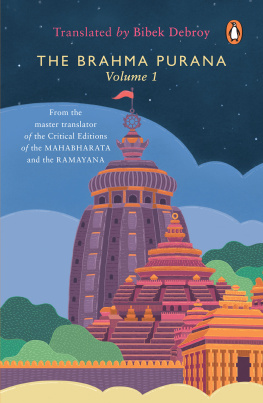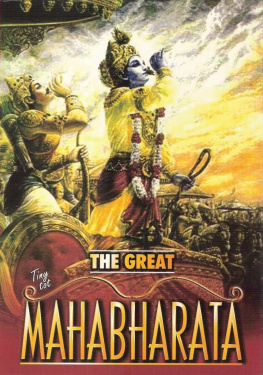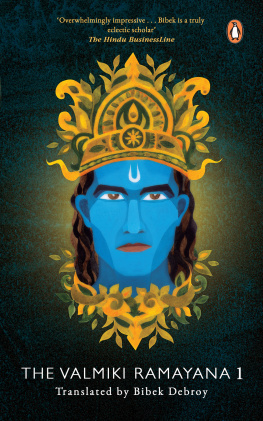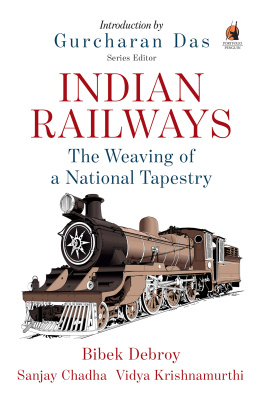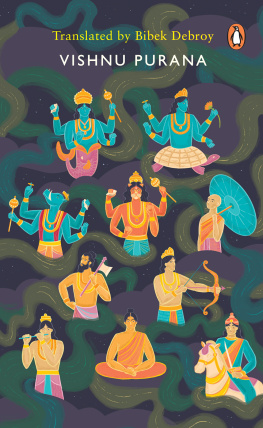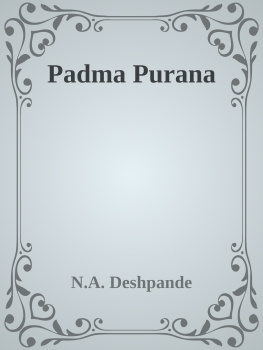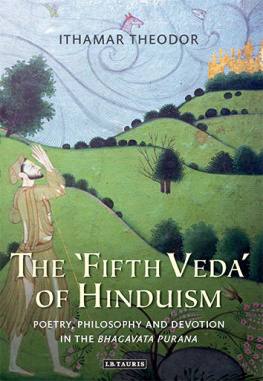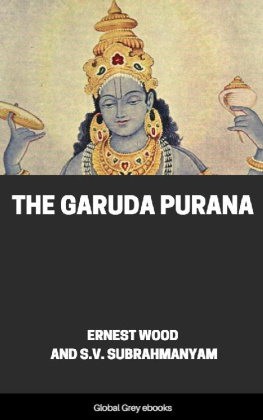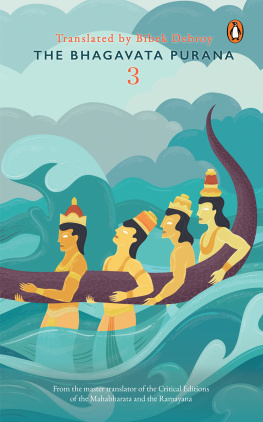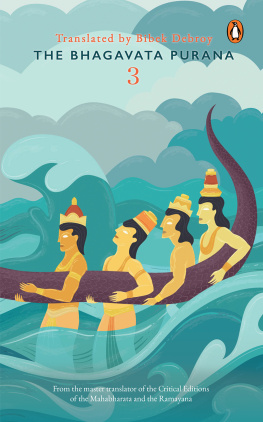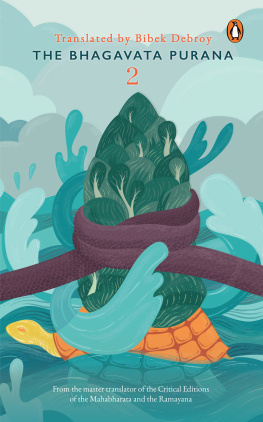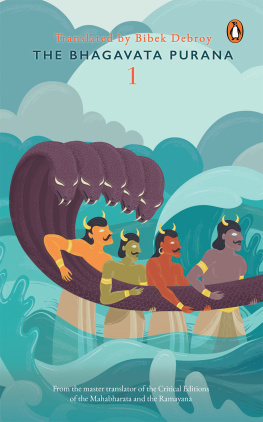Bibek Debroy is a renowned economist, scholar and translator. He has worked in universities, research institutes, the industry and for the government. He has widely published books, papers and articles on economics. As a translator, he is best known for his magnificent rendition of the Mahabharata in ten volumes, the three-volume translation of the Valmiki Ramayana and additionally the Harivamsha, published to wide acclaim by Penguin Classics. He is also the author of Sarama and Her Children, which splices his interest in Hinduism with his love for dogs.
PRAISE FOR THE MAHABHARATA
The modernization of language is visible, its easier on the mind, through expressions that are somewhat familiar. The detailing of the story is intact, the varying tempo maintained, with no deviations from the original. The short introduction reflects a brilliant mind. For those who passionately love the Mahabharata and want to explore it to its depths, Debroys translation offers great promise...Hindustan Times
[Debroy] has really carved out a niche for himself in crafting and presenting a translation of the Mahabharata... The book takes us on a great journey with admirable easeIndian Express
The first thing that appeals to one is the simplicity with which Debroy has been able to express himself and infuse the right kind of meanings... Considering that Sanskrit is not the simplest of languages to translate a text from, Debroy exhibits his deep understanding and appreciation of the mediumThe Hindu
Debroys lucid and nuanced retelling of the original makes the masterpiece even more enjoyably accessibleOpen
The quality of translation is excellent. The lucid language makes it a pleasure to read the various stories, digressions and parablesTribune
Extremely well-organized, and has a substantial and helpful Introduction, plot summaries and notes. The volume is a beautiful example of a well thought-out layout which makes for much easier readingBook Review
The dispassionate vision [Debroy] brings to this endeavour will surely earn him merit in the three worldsMail Today
Debroys is not the only English translation available in the market, but where he scores and others fail is that his is the closest rendering of the original text in modern English without unduly complicating the readers understanding of the epicBusiness Standard
The brilliance of Ved Vyasa comes through, ably translated by Bibek DebroyHindustan Times
PRAISE FOR THE VALMIKI RAMAYANA
It is a delight to read Bibek Debroys translation of the Valmiki Ramayana. Its like Lord Ram has blessed Dr Debroy, and through him, blessed us with another vehicle to read His immortal storyAmish Tripathi
Bibek Debroys translation of the Ramayana is easy to navigate... It is an effort for which Debroy deserves unqualified praiseBusiness Standard
A nuanced translation of a beloved epic... There is much to recommend this three volume set that can renew our interest in the Ramayana, surely one of the greatest stories ever toldIndian Express
PRAISE FOR THE BHAGAVATA PURANA
An exhaustive but accessible translation of a crucial mythological text
Indian Express
The beauty of recounting these stories lies in the manner in which the cosmic significance and the temporal implications are intermingled. Debroys easy translation makes that experience even more sublimeBusiness Standard
The Puranas are 18 volumes with more than four lakh shlokas, and all in Sanskritthe language of our ancestors and the sages, which only a few can speak and read today and only a handful have the mastery to translate. Bibek Debroy is one such master translator, who wears the twin title of economist and Sanskrit scholar, doing equal justice to bothOutlook
For Shaifalika Panda and Subhrakant Panda
Introduction
The word Purana means old, ancient. The Puranas are old texts, usually referred to in conjunction with Itihasa (the Ramayana and the Mahabharata). In other words, ItihasaPurana possessed an elevated status. This by no means implies that the word Purana, as used in these two Upanishads and other texts too, is to be understood in the sense of the word being applied to a set of texts known as the Puranas today. The Valmiki Ramayana is believed to have been composed by Valmiki and the Mahabharata by Krishna Dvaipayana Vedavyasa. After composing the Mahabharata, Krishna Dvaipayana Vedavyasa is believed to have composed the Puranas. The use of the word composed immediately indicates that ItihasaPurana are smriti texts, with a human origin. They are not shruti texts, with a divine origin. Composition does not mean these texts were rendered into writing. Instead, there was a process of oral transmission, with inevitable noise in the transmission and distribution process. Writing came much later.
Pargiters book on the Puranas is still one of the best introductions to this corpus. and they describe the sutas duty... The Vayu, Brahmanda and Visnu give an account on how the original Purana came into existence. Those three Puranas say: Krishna Dvaipayana divided the single Veda into four and arranged them, and so was called Vyasa. He entrusted them to his four disciples, one to each, namely Paila, Vaisampayana, Jaimini and Sumantu. Then with tales, anecdotes, songs and lore that had come down from the ages, he compiled a Purana, and taught it and the Itihasa to his fifth disciple, the suta Romaharsana or Lomaharsana... After that he composed the Mahabharata. The epic itself implies that the Purana preceded it... As explained above, the sutas had from remote times preserved the genealogies of gods, rishis and kings, and traditions and ballads about celebrated men, that is, exactly the materialtales, songs and ancient loreout of which the Purana was constructed. Whether or not Vyasa composed the original Purana or superintended its compilation, is immaterial for the present purpose. After the original Purana was composed, by Vyasa as is said, his disciple Romaharsana taught it to his son Ugrasravas, and Ugrasravas the sauti appears as the reciter in some of the present Puranas; and the sutas still retained the right to recite it for their livelihood. But, as stated above, Romaharsana taught it to his six disciples, at least five of whom were brahmans. It, thus, passed into the hands of the brahmans, and their appropriation and development of it increased in the course of time, as the Purana grew into many Puranas, as Sanskrit learning became peculiarly the province of the brahmans, and as new and frankly sectarian Puranas were composed. Pargiter cited reasons for his belief that the Mahabharata was composed after the original Purana, though that runs contrary to the popular perception about the Mahabharata having been composed before the Puranas. That popular and linear perception is too simplistic, since texts evolved in parallel, not necessarily sequentially.

